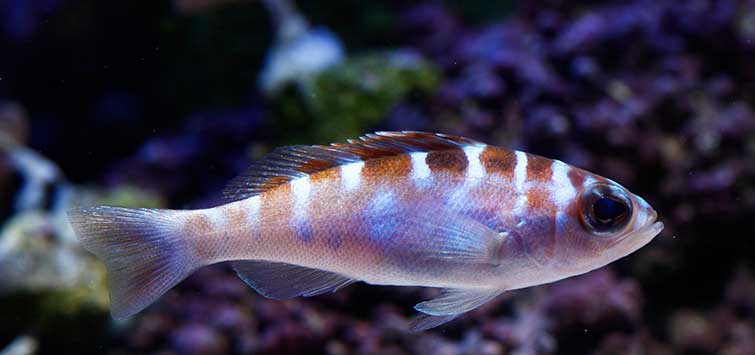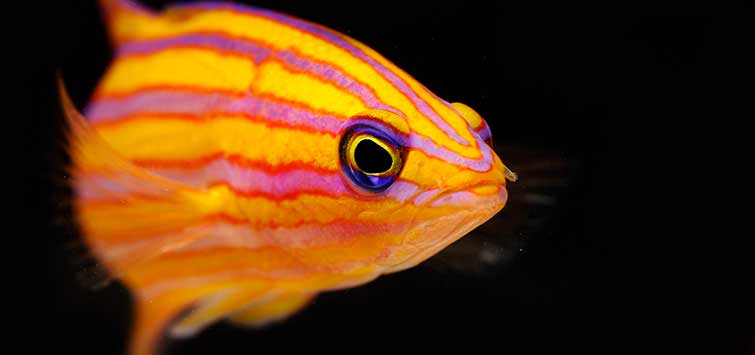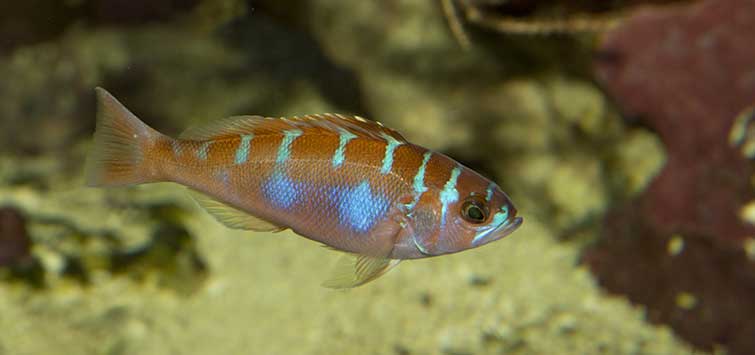The Atlantic Chalk Bass Serranus tortugarum
Author: Edward A. Jackson
The Atlantic chalk bass is a somewhat unknown species in the trade, but a marine fish enthusiast explains that this hardy, beautiful, and personable fish deserves more appreciation in the hobby.
Sad Practices in the Aquarium Hobby
The end of 2010 marked my tenth year in the hobby, and even in that relatively short time, I’ve seen an enormous amount of positive change and advancements in all aspects of the hobby and trade. From the wider implementation of macro-algae refugiums to the employment of more energy-efficient lighting systems such as LEDs, plus the continued advancement of aquaculture—even with animals many believed were impossible to raise in captivity—these advancements have made our hobby more ecologically sound and self sustaining. There are, however, some bad practices that continue to trend despite widely available information.
Sad Staples
It amazes me that certain animals still remain staples in the trade. For example, amateur aquarists are still regularly dabbling with the likes of Moorish idols, cleaner wrasses, and Goniopora spp. The list could go on to the point that it depresses me, so I won’t continue.
Where Are All the Good Fish?
Likewise, I am also amazed that certain animals that are prime candidates for the ornamental trade—both because they can be collected in a sustainable manner and that they tend to succeed in aquariums—continue to remain on the fringes of the hobby. While a cynical person might accuse suppliers of greed, I believe this is more an issue of ignorance than one of maliciousness, even if economics play a role.
Many aquarists do not know what animals are most appropriate for their tanks and therefore do not request them from their retailers. This creates a vicious supply-and-demand cycle where importers continue to order less-than-ideal choices from exporters because the demand remains for them. In short, your local dealer does not stock animals because people do not ask for them, and because of the lack of knowledge among consumers, people don’t know to ask for them because they never see them. See the problem here?
The Underrated Atlantic Chalk Bass
One ideal species that in my experience continues to suffer from this unfortunate conundrum is Serranus tortugarum, the chalk bass. It’s attractive, small, easy to collect, a good shipper, a hearty eater of most prepared aquarium fare, compatible with a multitude of other fish and invertebrate life, and vastly underutilized in our hobby. (A note to significant others: It’s pretty cheap too!)
In the Wild
A decidedly Atlantic species, the chalk bass has a wide distribution in that ocean, hailing from Florida’s eastern coast to the Bahamas, Virgin Isles, even Honduras, though its largest populations are in Caribbean reefs. It has a wide distribution within the reef as well, inhabiting depths of 35 to 1310 feet.
Location
They are typically found in close association with the benthic regions of the reef and substrate, not too often daring into open space due to their diminutive size and quickly retreating from would-be predators into the nearest possible crevice or empty seashell.
Social Behavior
While singular specimens are seen, they are social animals typically occurring in loose groups or schools with a distinct pecking order. S. tortugarum is synchronously hermaphroditic, meaning they maintain both male and female reproductive organs simultaneously, but as far as we know they cannot self fertilize. This species is a zooplanktivore, though larger specimens have been known to consume crustaceans that they could fit whole in their mouth. Mature adults can reportedly reach a maximum size of just 3 inches in the wild, though 2 inches is much more common.
Appearance
The appearance of this fish varies greatly depending on the type of lighting it’s viewed under and its environment, as its pigmentation changes slightly to help camouflage the animal. Typically they are a vibrant blue to turquoise, with the dorsal divided by black or burgundy stripes.
Selection
This is an extremely resilient animal that is highly suitable in adapting to captive environments, and healthy specimens have very little trouble doing so. Once they’ve overcome the shock of the initial transition and their natural predisposition to be reclusive, they should quickly begin accepting prepared foods. I would wait until this animal has been in a dealer’s tank for upward of two weeks to be safe, as those that succumb to the rigors of poor collection should be expunged from the group by that point. Avoid specimens that are emaciated or have visible contusions and injuries. Also be sure to ask your dealer to offer it food in your presence, and shun those specimens that seem uninterested.
If you plan to keep more than one S. tortugarum in your display, it’s best to purchase them in groups of three or five that were collected together. They should be quarantined together and added to the display simultaneously to avoid aggression and rejection.
Captive Care
Acclimation
It’s quite normal for S. tortugarum to be reclusive when first added to the home aquarium, retreating into whatever shelter you make available to them. You can encourage them into the open by utilizing a subdued lighting scheme initially and offering live Artemia or mysids to encourage natural feeding behavior. Chalk basses are also very likely to jump during this initiatory phase to new surroundings, so you may want to consider employing a hood or cover at least for the first few weeks.
Habitat
S. tortugarum and members of the Serranus genus generally make great additions to biotopic displays of the tropical Atlantic. Their relatively small size makes them ideal for smaller or even nano marine aquaria—if keeping a lone specimen. If you plan to keep them as a group, allow 15 to 20 gallons per individual.
Providing protection via some form of shelter, preferably live rock and larger seashells, is a must for the chalk bass in order for them to thrive. While you should keep a regular regime of water changes and utilize other forms of nutrient export such as a protein skimmer, established S. tortugarum are typically very tolerable of water quality that temporarily lingers outside of proper parameters, making it ideal for beginners.
Feeding
S. tortugarum will readily accept a wide variety of prepared captive fare. Being mainly zooplanktivores, they will prey on the naturally occurring live mircrofauna found in most reef displays or aquariums employing the use of live rock. A variation of finely chopped meats of a marine origin should also be offered, including but not limited to mysis, krill, squid, as well as other bivalve and crustacean meats. Established specimens should eventually accept more convenient dried fare, as well as pellets and flakes with high protein content.
Disease/Injury Treatment
Like their other larger cousins within the family Serranidae, this species is hardy and resilient against most protozoal diseases and bacterial infections. When you quarantine before introduction to the main display, add PVC pipe or some other form of inert shelter during their stay.
Compatibility
Excluding conspecifics and congeners (members of the genus Serranus), chalk bass are compatible with a wide array of other fish. Of course, you must avoid tankmates that will consume or harass them. This includes all predators such as lionfish, triggers, and larger basses. In close quarters (smaller aquaria), aggressive damsels, including clownfish, should be added with extreme caution. On the other hand, S. tortugarum is safe with sessile invertebrates and larger crustaceans, but hungry or curious adults may attempt to consume smaller shrimp like the anemone shrimp Thor amboinensis.
Ask for a Sea Bass
Easily attainable if you know to ask for them, these miniature sea basses are a great addition for veteran and first-time aquarists alike. One of the more obvious examples of animals underrepresented in the ornamental trade, the lack of promotion given to the chalk bass is frustrating as nails on a…well, you get the idea!
See the full article on TFH Digital http://www.tfhdigital.com/tfh/201111#pg79

.png?h=595&iar=0&w=2781&hash=5FD5E69473BCC22199FBFA2FB71B6033)



